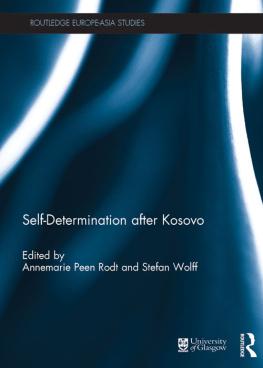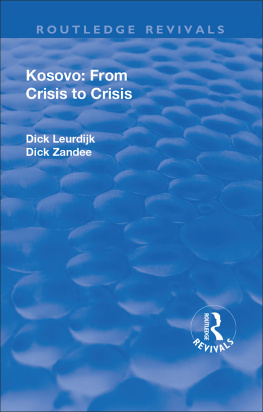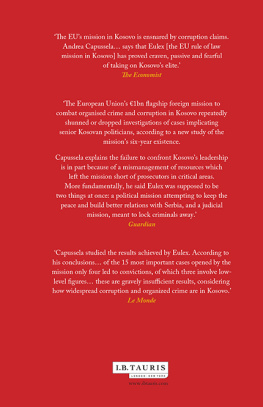Preface
This book was the most difficult project I have undertaken until now. Experientially, it started with a harrowing experience in the summer of 1997, when I returned to my Albanian hometown of Vlora after my first year of college. Because the Albanian state had collapsed after a pyramid scheme scandal, violent gangs were holding the town hostage. A gangster stopped our bus and almost shot me and my father when he demanded payment. When I returned to college in the autumn, I took more political science courses because I wanted to understand the bigger issues of peace, order, and reconstruction.
In 1999, the Kosovo war ended, and I was accompanying Kosovo refugees who were returning to their homes from the refugee camps in Albania. I was sitting next to a family that included grandparents, parents, and young children. The children were singing nationalist Kosovo Albanian songs, while the parents and grandparents were looking through the windows at the broken roads and destroyed houses. White sport utility vehicles with the logos of the United Nations or nongovernmental organizations jostled in the road next to convoys of NATO peace enforcer troops from fifty countries. It seemed that the whole world was investing in Kosovo in order to make it peaceful, democratic, and prosperous. I wondered then whether these Kosovo children and their families would be able to live in peace in the future.
I would return to Kosovo in 2006, and then for a year in 20089, to conduct research for my doctoral dissertation at Cornell University. Kosovo had been at peace, even though the riots in 2004 had marred its reputation. However, people were disappointed with the level of democracy and state protection. And by this time, I had become frustrated with Kosovos political and economic development. My initial hunch was that the international actors had failed to build Kosovos institutions because they were too distant from local knowledge.
During my fieldwork, however, I found out that I was wrong. Political interference in the new state institutions had undermined Kosovos state building, while international insulation had contributed to the development of a professional police force and customs service. However, that story only covered state building. If I did not include democratization, the implication of my study would be that it was enough to build strong state institutions to provide security and other services to the citizens. However, strong state institutions can be repressive if they are not responsive to the society in a democratic fashion. Therefore, I studied the process of creating the democratic institutions in Kosovo as well as state building. Curiously, I found that local ownership and knowledge had a strong positive impact on democratization. Therefore, the path to democratization was different from the path to effective state bureaucracies.
This book is not a historical overview of the Kosovo conflict but rather an investigation of how international and local actors have built state bureaucracies and democratic institutions in Kosovo. Although the study explores structural conditions and historical legacies, it puts a strong emphasis on the political choices made by various actors, ranging from international bureaucrats and local politicians to ordinary people.
In the past decade, Kosovo has been a rich ecological site of international and local experimentation, and this book tries to explain a small part of this diverse landscape. Though my findings contribute to various academic literatures, my hope is that what I learned in the seven years I spent researching and writing this book would also help various international and local organizations formulate better strategies for building democratic institutions and effective state bureaucracies.
An obligatory note on the spelling of the names in this book is in order. Kosovo is a contested state, and therefore the names of places within it are also contested. Some readers might try to detect a nationalist bias in this thesis, but I hope they are disappointed. Wherever possible, I have tried to use the English usage for the names of places. Therefore, I use Kosovo and not its Albanian name Kosova, just as we use Germany instead of Deutschland. Some place names are the same in Albanian and Serbian, such as the town of Prizren. However, Gjakov in Albanian is Djakovica in Serbian. The capital of Kosovo is called Prishtin in Albanian and Pritina in Serbian. Throughout the book, I use Prishtina. In this text, Kosovo Albanian, Albanian, and Kosovar refer to Albanians from Kosovo and not to Albanian-speaking people in Albania or Macedonia. The term Kosovan is new and refers to all the residents of Kosovo, including those in communities who do not speak Albanian as their first language.
Many interviewees gave me frank answers that could endanger their jobs and livelihoods if such quotations were traced back to them. To protect the anonymity of my sources, I have used first-name pseudonyms for most of them (these names are listed with the other references at the end of the book). A few times, however, my respondents asked me to quote them using their real name, and I honored this request when their comments did not endanger them.
I could not have done this research without the support of so many peers and mentors. I was lucky indeed with my PhD dissertation committee at Cornell University. Valerie Bunce gave me the idea to look at how international actors build state institutions as my dissertation project, and she supported me through the highs and lows of fieldwork and writing. When I was hurrying to start a different project, Valerie wisely told me that I would be better off doing something else. Matthew Evangelista helped me both focus my questions analytically and think in broader terms. Nicolas van de Walle always generously shared his depth of knowledge about the international aid industry. David Patel asked hard questions about method and theory and pushed me in my analysis. And none of them minded that I changed my hypothesis after the fieldwork; they were always supportive. I have learned a lot about mentoring from them all, and hope to be able to apply these lessons with my future mentees. I have learned significantly from the other professors I knew at Cornell, who were kind and supportive to me. With his six pages of general and specific comments, Peter Katzenstein, the external reader in my defense, lived up to his reputation for thorough and useful feedback. Many thanks also go to professors Chris Anderson, Richard Bensel, Holly Case, Maria Koinova, Ken Roberts, and Chris Way.
I could not have asked for better publishers than Cornell University Press and Woodrow Wilson Center Press. Roger Haydon and Joe Brinley were supportive and thoughtful throughout the revision process. This is the first book to be published as a collaboration between these two presses. I hope this cooperative arrangement continues in the future.
I have shared with my peers at Cornell the journey and tribulations of working for a doctorate in the social sciences. Govind Acharya, Lucia Antalova-Sybert, Michael Bobick, Noelle Brigden, Jennifer Hadden, Gaurav Kampani, Alison McQueen, Steve Nelson, Tsveta Petrova, Tariq Thachil, and many others graciously read my drafts and listened to my half-baked ideas, providing essential intellectual and emotional support. The community of peace studies at Cornell also supported me through the various stages of this project. The peace studies fellowship also provided a breathing space for my dissertation prospectus write-up and dissertation writing. I would like to especially acknowledge Chip Gagnon and Judith Reppy within the peace studies community for their insightful comments. In addition, this research project has received funding from the American Council of Learned Societies Committee on East European Studies, the Smith Richardson Foundation, the Woodrow Wilson International Center for Scholars, the Kroc Institute for International Peace at the University of Notre Dame, and the International Research and Exchanges Boards short-term travel grant.













